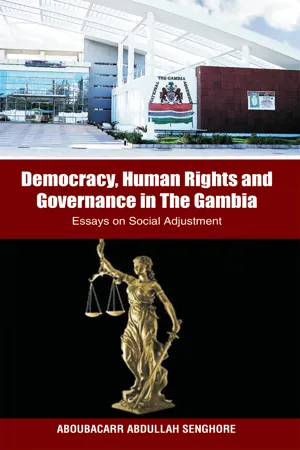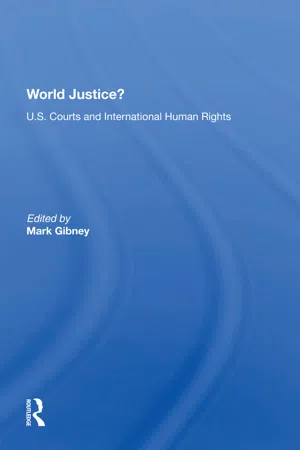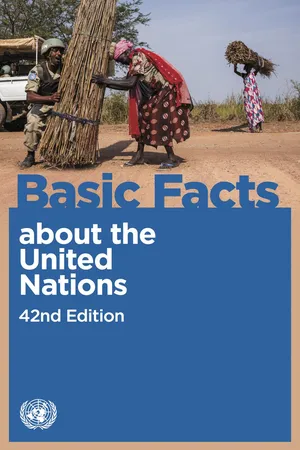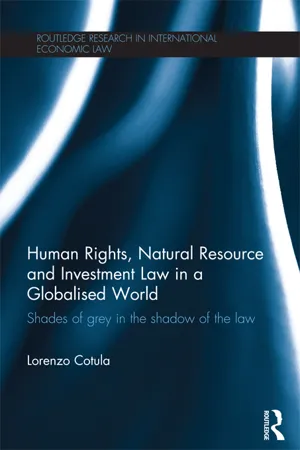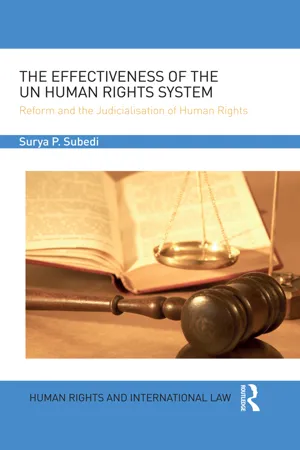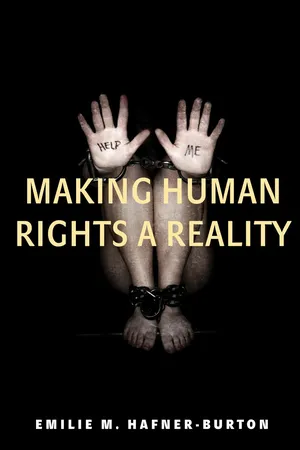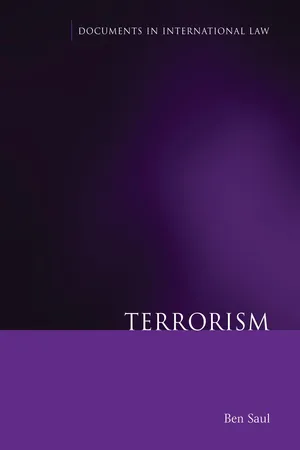Law
International Human Rights
International human rights refer to the fundamental rights and freedoms that are universally recognized and protected by international law. These rights encompass civil, political, economic, social, and cultural rights, and are enshrined in various international treaties and conventions. They are intended to ensure the dignity, equality, and well-being of all individuals, regardless of their nationality, ethnicity, religion, or other characteristics.
Written by Perlego with AI-assistance
Related key terms
11 Key excerpts on "International Human Rights"
- eBook - ePub
The Legalization of Human Rights
Multidisciplinary Perspectives on Human Rights and Human Rights Law
- Saladin Meckled-García, Basak Çali(Authors)
- 2006(Publication Date)
- Routledge(Publisher)
The features explained by NRM, then, include who the rights apply to (who the right holder is), who they impose duties upon (the duty bearer), the content of the duties, and what constitutes adequate securing (in line with these respective duties), and the source of interpretation in settling issues of conflict of interests and rights. It is these features that will be shown to diverge substantively from human rights law. To show that this is the case, we will take each apparent divergence and try to bring to bear moral considerations relating to the human rights ideal which might justify the apparent divergence.International Human Rights law
By human rights law we mean something quite precise: a form of public international law creating rights for individuals and duties for states, as well as domestic and international remedies for violation of rights and failure of duties. International treaties and customs that deal with human rights have a different character to those that deal with war crimes, crimes against humanity and genocide. We do not consider the latter to be part of the body of human rights law proper, although they all come under the broad category of humanitarian concern. Their subject matter is often, and in our view wrongly, elided with human rights law, simply because both are concerned with the protection of people against abuses. 6 However, the similarities stop there. Human rights provisions are those which give entitlements to individual persons, individually or in some cases collectively, to make legal claims before public authorities and where the legal support for these claims is said to respect these individuals’ entitlements as human persons (Feinberg 1980, 2003).IHRL is constituted by that set of international instruments and institutions which explicitly determine the human rights of persons. It includes the international and regional human rights obligations of states, either stemming from international treaties or customary international law. 7 - eBook - ePub
Democracy, Human Rights and Governance in The Gambia:
Essays on Social Adjustment
- Abdullah Senghore(Author)
- 2018(Publication Date)
- CENMEDRA(Publisher)
Expressions like International Human Rights law, international protection of human rights and international bill of human rights, are sometimes used to refer to this branch of the Law of Nations (LN). The latter expression is, however, confined to major human rights treaties concluded at the level of the United Nations i.e. the Universal Declaration of Human Rights (UDHR), the International Covenant on Civil and Political Rights (ICCPR), the International Covenant on Economic, Social and Cultural Rights (ICESCR) and other subsidiary conventions dealing with human rights promotion and protection. 46 International Human Rights have, by virtue of its definition, significantly departed from the traditional attitude of international law which is usually defined as the law governing relations between nation states exclusively binding on them in their mutual intercourse. 47 Although, the scope of the definition of international law was somewhat expanded after the First World War to include some of the newly created intergovernmental organizations deemed to deserve some or certain limited rights under international law, individual human beings were still excluded and not deemed to deserve international legal rights as such. Instead, they were said to be objects rather than subjects of international law. Furthermore, the law of Nations was in its very nature still inapplicable to the manner in which a state treated its own people as this was entirely within the state’s domestic jurisdiction. Oppenheim did, however, indicate that individuals might, under certain circumstances, be conferred rights and imposed duties of international law - eBook - ePub
World Justice?
U.S. Courts And International Human Rights
- Mark Gibney(Author)
- 2021(Publication Date)
- Routledge(Publisher)
5International Human Rights Law and U.S. LawDOI: 10.4324/9780429268038-5John M. RogersBecause of the often imprecise use of the term "human rights," along with widespread misunderstanding of the relationship between international law and domestic law, it is not surprising that the subject of enforcement of human rights in United States courts is confusing. Unfortunately, the confusion may lead some who are most vigorously opposed to human rights violations to advocate legal positions that in the long run do little to advance human rights, and that may harm other important policy considerations. Some lawyers argue, for instance, that the public international law of human rights is directly applicable law in United States courts, just like the United States Constitution.1 What follows is a modest attempt to clarify the subject, with the hope that this may to some extent serve to channel human rights advocacy in directions most likely to be effective.Definitions
It is helpful at the outset to think of human rights as limits on the ways that governments interact with people. It is of course possible to conceive of human rights more broadly. For instance, every obligation of any sort to a person, whether from another person, from a private organization, from a government, or even from God, could effect a "right," and by virtue of the fact that the obligation is to a person, the right could be called a "human right." Such a definition would not be very useful; it would incorporate much of law as we know it: public law, private law, even religious law, and maybe even systems of moral obligations. For instance, if Terry promised Leslie never to lie to Leslie, we might say that Leslie has a right not to be lied to by Terry. By virtue of the fact that Leslie is a person, we might call this a "human right," even though Leslie has no legal right never to be lied to, and even though the lie may not be very significant. The definition is not useful because it is too broad: any discussion of enforcement, for instance, would comprehend the entire subject of ethics. We would simply have to create a subset of "human rights" in order to discuss the kinds of protections commonly associated with the idea of "human rights." - eBook - ePub
- United Nations Department of Public Information(Author)
- 2017(Publication Date)
- United Nations(Publisher)
International Human Rights Day . Its 30 articles spell out basic civil, cultural, economic, political and social rights that all human beings in every country must enjoy.Articles 1 and 2 state that “all human beings are born equal in dignity and rights” and are entitled to all the rights and freedoms set forth in the Declaration “without distinction of any kind such as race, colour, sex, language, religion, political or other opinion, national or social origin, property, birth or other status”.Articles 3 to 21 set forth the civil and political rights to which all human beings are entitled, including:■ the right to life, liberty and security;■ freedom from slavery and servitude;■ freedom from torture or cruel, inhuman or degrading treatment or punishment;■ the right to recognition as a person before the law, the right to judicial remedy;■ freedom from arbitrary arrest, detention or exile; the right to a fair trial and public hearing by an independent and impartial tribunal; the right to be presumed innocent until proved guilty;■ freedom from arbitrary interference with privacy, family, home or correspondence;■ freedom from attacks upon honour and reputation; the right to protection of the law against such attacks;■ freedom of movement; the right to seek asylum; the right to a nationality;■ the right to marry and to found a family; the right to own property;■ - eBook - ePub
- J. Alberto del Real Alcalá(Author)
- 2017(Publication Date)
- Bentham Science Publishers(Publisher)
An important factor to be borne in mind also is the international regulation of the human rights concerning the phenomenon of the migration, since it constitutes a fundamental modality in the existing general consideration on this phenomenon. In addition to the reviewed proclamations of the right to migrate like human right in the main international declarative texts of human rights, the International Law offers regulations based on beginning, recommendations, institutions and procedures based in turn on the fundamental beginning of the agreement of the sovereign States. And so, it is the self-regulation sustained on the principle of autonomy of its will and the bona fide principle, the fundamental criterion for its normative joint on a global scale, specified in agreements, treaties, pacts, protocols,… celebrated between the States signatories.The hierarchy relations between the International Law and the internal Law of every State are variable depending on the country that we consider; nevertheless, the general principle is that the State has the power to define them in its own arranging, although the agreements and adopted commitments cannot be avoided in the assumption of which the State that is a part in one of them decides that its internal Law prevails over the international Law from a certain moment, unless such instruments violate its internal norms of clear and self-evident form (Vienna Convention on the Law of Treaties, May 23, 1969).In the concrete field of the international regulation on human rights, the international agreements of the United Nations are the main modality, imposing juridical duties for all the countries that ratify them and that adhere to them, in the sense of recognizing them, of respecting them, of protecting them and of guaranteeing them, proclaiming them in its internal arranging with the status of fundamental - eBook - ePub
Human Rights, Natural Resource and Investment Law in a Globalised World
Shades of Grey in the Shadow of the Law
- Lorenzo Cotula(Author)
- 2012(Publication Date)
- Routledge(Publisher)
By its very nature, the international protection of property rights against adverse state interference redefines the parameters for the lawful exercise of state sovereignty: states are able to lawfully take action that encroaches on protected property rights only if certain conditions are met. Governments have been prepared to accept these restrictions to promote respect for human dignity, or to facilitate economic activities. Two branches of international law are particularly relevant. International Human Rights law recognises the right to property, the right to food, peoples’ right to dispose freely of their natural resources, the rights of indigenous peoples over their ancestral territories and several other rights that have direct implications for the protection of property rights. Enjoyment of most of these rights is inherently restricted to natural persons, including people who may be affected by natural resource investments. But the right to property has been successfully relied on by both natural persons and corporations, and it may protect both investors and affected people. The second relevant branch of international law is investment law, which protects foreign investment.International Human Rights and investment law share important commonalities. By setting minimum standards of protection and providing international mechanisms for the judicial review of adverse government action, these two bodies of law protect non-state actors against the arbitrary exercise of state sovereignty. International Human Rights and investment law also present numerous – if, to date, somewhat isolated – areas of contact. Some investment arbitrators have used concepts developed by human rights courts. In Técnicas Medioambientales Tecmed, S.A. v. United Mexican States, the arbitral tribunal referred to the proportionality doctrine developed by the European Court of Human Rights.7 In Ronald S. Lauder v. Czech Republic, the tribunal drew on human rights law to define the legal construction of expropriation.8 And in Saipem S.p.A. v. Bangladesh, the arbitral tribunal relied on the jurisprudence of the European Court of Human Rights to find that measures undermining a legal claim established by an arbitral award may constitute expropriation.9 In addition, international investment rules have been used to protect investments that can be seen as instrumental to the enjoyment of human rights, such as investments in publishing houses and media enterprises with regard to the realisation of freedom of expression.10 Finally, the human rights protection of property has provided foreign investors with an additional avenue to defend their interests. In a recent case, an investor brought a dispute to the European Court of Human Rights following the persistent refusal of a state to enforce an arbitral award; the European Court found that such refusal violated the right to a fair trial and the right to property under the European Convention on Human Rights (ECHR).11 - eBook - ePub
The Effectiveness of the UN Human Rights System
Reform and the Judicialisation of Human Rights
- Surya Subedi, OBE, QC (Hon)(Authors)
- 2017(Publication Date)
- Routledge(Publisher)
To find out which countries have ratified the International Human Rights treaties: http://indicators.ohchr.org/. For information on the status of ratification and signature by States of UN human rights treaties, as well as reservations and declarations: http://treaties.un.org/Pages/Treaties.aspx?id=4&subid=A&lang=en. An overview of the ratification status is also available at: http://tbinternet.ohchr.org/_layouts/TreatyBodyExternal/Treaty.aspx 77 This Convention has been ratified by all 193 members of the UN. 78 A/RES/60/1 of 24 October 2005. 79 The text of the Charter of the United Nations can be accessed online, http://www.un.org/en/documents/charter/intro.shtml accessed 10 October 2014. 80 The term ‘International Human Rights law’ encompasses the various human rights treaties, declarations of the UN and other international conferences which are capable of carrying some legal weight, procedures and principles of customary international law and case-law. In defining this term reference could be made to Article 38 of the Statute of the International Court of Justice, part of the UN Charter, which has generally been regarded as the most authoritative definition of the sources of international law. It reads as follows: The Court, whose function is to decide in accordance with international law such disputes as are submitted to it, shall apply: a. international conventions, whether general or particular, establishing rules expressly recognized by the contesting States; b. international custom, as evidence of a general practice accepted as law; c. the general principles of law recognized by civilized nations; d - eBook - ePub
- Emilie M. Hafner-Burton(Author)
- 2013(Publication Date)
- Princeton University Press(Publisher)
They found that Americans were more willing to support actions intended to punish Myanmar’s military junta when they were aware that a government had violated nonbinding legal principles spelled out in the Universal Declaration for Human Rights. (Interestingly, this willingness did not increase when people were informed that the conduct also violated a specific treaty commitment—suggesting that it matters a lot more for voters whether a norm exists than if it is written into binding treaty law.) The effect of the law was most evident for lesser crimes, such as forced labor without compensation. Still, Americans were unwilling to support any punishment if they believed that might undermine other US interests, regardless of the law. 9 It isn’t surprising that international law is associated with protections for civil and political rights in advanced democracies; after all, those are the countries that are often driving the formation of International Human Rights law and already have the conditions in place to protect human rights at home and push them abroad. Yet a body of statistical evidence has emerged showing that international law is also associated with protection for some human rights in some countries that are democratizing and at earlier stages of economic development (which itself frequently correlates with democratization). 10 For example, Beth Simmons concludes that international law has improved protection of human rights in countries “in flux,” with some democratic experience, where, she argues, law sparks political mobilization. 11 Those like Chile that have ratified treaties—protecting civil and political rights as well as women, and outlawing torture—are the more likely ones to grant rights to freer religious practices, improve educational opportunities for girls, and use less torture - eBook - ePub
Dignity and International Human Rights Law
An Introduction to the Punta del Este Declaration on Human Dignity for Everyone Everywhere
- Brett Scharffs, Ewelina Ochab(Authors)
- 2021(Publication Date)
- Routledge(Publisher)
(3) Some rest on the fact or possibility of a distribution of pleasure or happiness (or of the means thereto) which is not in accordance with the merit of the persons concerned; in such cases there arises a duty to upset or prevent such a distribution. These are the duties of justice.(4) Some rest on the mere fact that there are other beings in the world whose condition we can make better in respect of virtue, or of intelligence, or of pleasure. These are the duties of beneficence,(5) Some rest on the fact that we can improve our own condition in respect of virtue or of intelligence. These are the duties of self-improvement.(6) I think that we should distinguish from (4) the duties that may be summed up under the title of ‘not injuring others.’” Id. , 21.30 Ghaidan v. Godin-Mendoza [2004] 2 AC (HL) 557, 605 (UK).Treaties
The International Covenant on Civil and Political Rights
The International Covenant on Civil and Political Rights (the ICCPR) mentions the concept of human dignity on three occasions. The Preamble to the ICCPR states:Considering that, in accordance with the principles proclaimed in the Charter of the United Nations, recognition of the inherent dignity and of the equal and inalienable rights of all members of the human family is the foundation of freedom, justice and peace in the world,Recognizing that these rights derive from the inherent dignity of the human person.Also, Article 10(1) of the ICCPR states, “All persons deprived of their liberty shall be treated with humanity and with respect for the inherent dignity of the human person.” Here, the importance of human dignity when the state has heightened power or control over a person is emphasized.The International Covenant on Economic, Social and Cultural Rights
The ICCPR’s preambular paragraphs on human dignity are repeated in the International Covenant on Economic, Social, and Cultural Right (the ICESCR). Also, Article 13(1) of the ICESCR states:The States Parties to the present Covenant recognize the right of everyone to education. They agree that education shall be directed to the full development of the human personality and the sense of its dignity, and shall strengthen the respect for human rights and fundamental freedoms. - eBook - ePub
Improving the Governance of International Migration
The Transatlantic Council on Migration
- (Author)
- 2012(Publication Date)
- Bertelsmann Stiftung(Publisher)
Section IV: An Expert Perspective on Human Rights and International Lawdp n="141" folio="149" ?Passage contains an image
The Role of International Law in the Governance of Migration and Protection of Migrants’ RightsJacqueline BhabhaIntroduction54
International law has had significant protective, regulatory, and restrictive impacts on migration, with varying degrees of benefit in the area of migrant rights.55 While some types of engagement with international norms have permitted states to detain, deport, and exclude migrants, other developments have enhanced migrants’ rights in practice over the last half century, most notably the refugee protection regime. However, as with all legal entitlements, the efficacy of international norms in practice depends on much more than the letter of the law. Often, the success of the standards governing the conduct of independent states depends on the efficacy of the legal and political mechanisms that translate the standards into domestic provisions.This chapter describes the international legal framework for migrants’ rights over the last half century, evaluates the effectiveness of formal legal instruments in protecting and enforcing such rights, and reflects on the larger question of whether adherence to international norms is enhanced through popular consensus, legislative innovation, or both. The chapter examines domestic obstacles to the realization of migrants’ rights and concludes that strategies aimed at expanding legal entitlements alone are insufficient and should not be the sole focus of those committed to enhancing migrants’ access to justice and equality. International treaties are required, but also protective policies and social frameworks, such as the expansion of access to legal services, legal literacy, and post-litigation monitoring and evaluation.A key aspect of this work is the documentation of enforcement failures following unpopular court judgments. The chapter concludes that a mixed strategy of norm-creation (from above, via legislation) and consensus-building (from below, via advocacy and litigation) has the greatest potential for making an enduring contribution to the protection of migrants’ rights. - eBook - ePub
- Ben Saul(Author)
- 2012(Publication Date)
- Hart Publishing(Publisher)
2. Human rights law strikes a balance between the enjoyment of freedoms, and legitimate concerns for national security. It allows the limitation of some rights in specific and defined circumstances. 3. Where this is permitted, the laws authorising restrictions: § should use precise criteria; § may not confer unfettered discretion on those charged with their execution. 4. For limitations of rights to be lawful they must: § be prescribed by law;§ be necessary in a democratic society, be for public safety or public order, namely the protection of public health or morals and for the protection of the rights and freedoms of others, and serve legitimate purpose;§ not impair the essence of the right; § be interpreted strictly in favour of the rights at issue; § be necessary; § conform to the principle of proportionality; § be appropriate to achieve their protective function; must be the least intrusive instrument amongst those which might achieve that protective function; § be compatible with the objects and purposes of human rights treaties; § respect the principle of non-discrimination; § not be arbitrarily applied. 5. Comments on the compliance of adopted anti-terrorist measures with International Human Rights could refer to whether the measures are compatible with, for instance: § the right to personal liberty (CCPR art. 9); § freedom of movement (CCPR art. 12), including the right of all persons to leave any country, including one’s own country (CCPR art. 12, para. 4); § the right to a fair trial, particularly in the determination of any criminal charge (CCPR arts. 14 and 15); § the protection against arbitrary interference with privacy, family, home or correspondence and against unlawful attack on honour and reputation (CCPR art. 17; § freedom of expression (CCPR art. 19); § the right to manifest one’s religion or belief (CCPR art. 18); § the right of peaceful assembly (CCPR art. 21); § freedom of association (CCPR art. 22);
Index pages curate the most relevant extracts from our library of academic textbooks. They’ve been created using an in-house natural language model (NLM), each adding context and meaning to key research topics.

